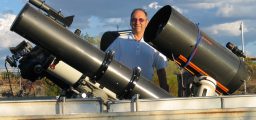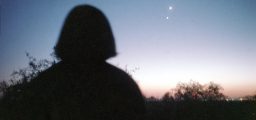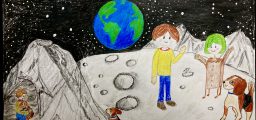Comets and Meteors and Meteorites, Oh My!

It’s a bird, it’s a plane, it’s a…
• Comet – A mass of ice, rock and dust which often has a tail. The tail is made up of water vapor, dust and various gases which vaporize and grows as it gets closer to the sun.
• Asteroid – A body made up of metallic and non-metallic rock orbiting the Sun and usually in the asteroid belt between Mars and Jupiter.
• Meteoroid – Often an asteroid fragment that although orbiting the sun, will make its way to entering Earth’s atmosphere.
• Meteor – When a meteoroid enters the Earth’s atmosphere, it becomes a meteor. As it travels through the atmosphere, it burns up, producing a streak of light. We commonly call these, Shooting Stars.
• Fireball – A rare event where a meteor explodes as it travels through Earth’s atmosphere, leaving behind a very bright streak of light.
• Meteorite – When a meteor traveling through Earth’s atmosphere does not completely burn up and strikes the ground, we call the fragment a meteorite.
Yikes! Will the Earth get struck?
Not to worry! Meteors are generally quite small, ranging from dust particles and rarely to boulder size. They are almost always small enough to quickly burn up in our atmosphere, and boulder size ones substantially reduce in size before hitting the ground and then becoming a meteorite.
How are meteors made?
When a comet gets closer to the sun, some of its surface vaporizes, releasing lots of ice, dust and rock particles. These particles follow along the comet’s path, and grow in number as the sun’s heat boils off more and more ice and debris. Then, as Earth travels around the sun, its orbit crosses the orbit of the comet and its tail… the particles. When many meteors enter our atmosphere at about the same time we experience a Meteor Shower.
What time of year do meteor shows happen?
January – Quadrantids
April – Lyrids
August – Perseids
October – Orionids
November – Leonids
December – Geminids
Why do the showers have strange names?
Meteor showers are named after the constellation where the meteors appear to be coming from. So, for example, the Orionids Meteor Shower, which occurs in October each year, appear to be originating near the constellation Orion the Hunter.
What’s the story on the upcoming August Perseid meteor shower?
From about July 17 to August 24, each year, the Earth crosses the orbital path of a comet that we call Comet Swift-Tuttle. It is this comet which gives off particles which we call the Perseid meteor shower.
Debris from Comet Swift-Tuttle follow the comet’s orbit, but we don’t cross path with the heavily populated section until after the first week of August.
The bits and pieces from Comet Swift-Tuttle enter the Earth’s upper atmosphere at a speed of approximately 130,000 miles per hour, lighting up the nighttime with beautiful Perseid meteors.
If you trace back to where the Perseid meteors seem to come from you will find the constellation Perseus, which is why the meteor shower is named as such. This, however, is a chance alignment as the stars in the Perseus constellation are light-years distant while the meteors in the shower burn up about 60 miles above the Earth’s surface. Few, if any meteors in meteor showers become meteorites.
Comet Swift-Tuttle
Comet Swift-Tuttle orbits the sun every 133 years and has a very oblong orbit which passes outside the orbit of Pluto when farthest from the sun, and inside the Earth’s orbit when closest to the sun.
It last reached perihelion, the closest point to the sun, in December 1992 and will do so again in July 2126.
Why do we call the constellation by the name of Perseus?
In ancient Greek mythology, Perseus was the son of the god Zeus and the mortal Danae. Upon his death, he was honored with a place in the heavens for a number of great accomplishments which included his killing of the Gorgon, Medusa. The Perseid shower commemorates the time when Zeus visited Danae in a shower of gold.
The Perseus constellation can be found just above the horizon on August 15th at approximately 11:30 PM Central.




Comments are closed.